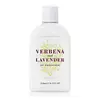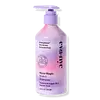What's inside
What's inside
 Key Ingredients
Key Ingredients

No key ingredients
 Benefits
Benefits

 Concerns
Concerns

 Ingredients Side-by-side
Ingredients Side-by-side

Water
Skin ConditioningGlycerin
HumectantDimethicone
EmollientC12-15 Alkyl Benzoate
AntimicrobialParfum
MaskingCaprylic/Capric Triglyceride
MaskingCetyl Palmitate
EmollientGlyceryl Stearate
EmollientSqualane
EmollientPEG-100 Stearate
Hydroxyethyl Acrylate/Sodium Acryloyldimethyl Taurate Copolymer
Emulsion StabilisingMoringa Oil/Hydrogenated Moringa Oil Esters
Skin ConditioningRosa Canina Fruit Oil
EmollientTocopheryl Acetate
AntioxidantRosmarinus Officinalis Leaf Extract
AntimicrobialOenothera Biennis Oil
EmollientDimethicone Crosspolymer
Emulsion StabilisingXanthan Gum
EmulsifyingDecylene Glycol
Skin ConditioningPolysorbate 60
EmulsifyingDisodium EDTA
Pentaerythrityl Tetra-Di-T-Butyl Hydroxyhydrocinnamate
AntioxidantAllantoin
Skin ConditioningSorbitan Isostearate
EmulsifyingHydroxycitronellal
PerfumingLimonene
PerfumingHexyl Cinnamal
PerfumingPanthenol
Skin ConditioningAlpha-Isomethyl Ionone
PerfumingLinalool
PerfumingCoumarin
PerfumingIsoeugenol
PerfumingCitral
PerfumingSodium Hydroxide
BufferingPhenoxyethanol
PreservativeWater, Glycerin, Dimethicone, C12-15 Alkyl Benzoate, Parfum, Caprylic/Capric Triglyceride, Cetyl Palmitate, Glyceryl Stearate, Squalane, PEG-100 Stearate, Hydroxyethyl Acrylate/Sodium Acryloyldimethyl Taurate Copolymer, Moringa Oil/Hydrogenated Moringa Oil Esters, Rosa Canina Fruit Oil, Tocopheryl Acetate, Rosmarinus Officinalis Leaf Extract, Oenothera Biennis Oil, Dimethicone Crosspolymer, Xanthan Gum, Decylene Glycol, Polysorbate 60, Disodium EDTA, Pentaerythrityl Tetra-Di-T-Butyl Hydroxyhydrocinnamate, Allantoin, Sorbitan Isostearate, Hydroxycitronellal, Limonene, Hexyl Cinnamal, Panthenol, Alpha-Isomethyl Ionone, Linalool, Coumarin, Isoeugenol, Citral, Sodium Hydroxide, Phenoxyethanol
Water
Skin ConditioningSodium Cocoyl Isethionate
CleansingCocamidopropyl Betaine
CleansingGlycerin
HumectantCocamidopropyl Hydroxysultaine
CleansingGlycol Distearate
EmollientAcrylates Copolymer
Cocamide Mipa
EmulsifyingArgania Spinosa Kernel Oil
EmollientHydrolyzed Adansonia Digitata Seed Extract
Hydrolyzed Vegetable Protein
Skin ConditioningPolyquaternium-10
Polyquaternium-7
Polyester-11
Skin ConditioningGuar Hydroxypropyltrimonium Chloride
Skin ConditioningTetrasodium Glutamate Diacetate
Aminomethyl Propanol
BufferingPotassium Sorbate
PreservativeSodium Benzoate
MaskingCitric Acid
BufferingPhenoxyethanol
PreservativeParfum
MaskingWater, Sodium Cocoyl Isethionate, Cocamidopropyl Betaine, Glycerin, Cocamidopropyl Hydroxysultaine, Glycol Distearate, Acrylates Copolymer, Cocamide Mipa, Argania Spinosa Kernel Oil, Hydrolyzed Adansonia Digitata Seed Extract, Hydrolyzed Vegetable Protein, Polyquaternium-10, Polyquaternium-7, Polyester-11, Guar Hydroxypropyltrimonium Chloride, Tetrasodium Glutamate Diacetate, Aminomethyl Propanol, Potassium Sorbate, Sodium Benzoate, Citric Acid, Phenoxyethanol, Parfum
Ingredients Explained
These ingredients are found in both products.
Ingredients higher up in an ingredient list are typically present in a larger amount.
Glycerin is already naturally found in your skin. It helps moisturize and protect your skin.
A study from 2016 found glycerin to be more effective as a humectant than AHAs and hyaluronic acid.
As a humectant, it helps the skin stay hydrated by pulling moisture to your skin. The low molecular weight of glycerin allows it to pull moisture into the deeper layers of your skin.
Hydrated skin improves your skin barrier; Your skin barrier helps protect against irritants and bacteria.
Glycerin has also been found to have antimicrobial and antiviral properties. Due to these properties, glycerin is often used in wound and burn treatments.
In cosmetics, glycerin is usually derived from plants such as soybean or palm. However, it can also be sourced from animals, such as tallow or animal fat.
This ingredient is organic, colorless, odorless, and non-toxic.
Glycerin is the name for this ingredient in American English. British English uses Glycerol/Glycerine.
Learn more about GlycerinParfum is a catch-all term for an ingredient or more that is used to give a scent to products.
Also called "fragrance", this ingredient can be a blend of hundreds of chemicals or plant oils. This means every product with "fragrance" or "parfum" in the ingredients list is a different mixture.
For instance, Habanolide is a proprietary trade name for a specific aroma chemical. When used as a fragrance ingredient in cosmetics, most aroma chemicals fall under the broad labeling category of “FRAGRANCE” or “PARFUM” according to EU and US regulations.
The term 'parfum' or 'fragrance' is not regulated in many countries. In many cases, it is up to the brand to define this term.
For instance, many brands choose to label themselves as "fragrance-free" because they are not using synthetic fragrances. However, their products may still contain ingredients such as essential oils that are considered a fragrance by INCI standards.
One example is Calendula flower extract. Calendula is an essential oil that still imparts a scent or 'fragrance'.
Depending on the blend, the ingredients in the mixture can cause allergies and sensitivities on the skin. Some ingredients that are known EU allergens include linalool and citronellol.
Parfum can also be used to mask or cover an unpleasant scent.
The bottom line is: not all fragrances/parfum/ingredients are created equally. If you are worried about fragrances, we recommend taking a closer look at an ingredient. And of course, we always recommend speaking with a professional.
Learn more about ParfumPhenoxyethanol is a preservative that has germicide, antimicrobial, and aromatic properties. Studies show that phenoxyethanol can prevent microbial growth. By itself, it has a scent that is similar to that of a rose.
It's often used in formulations along with Caprylyl Glycol to preserve the shelf life of products.
Water. It's the most common cosmetic ingredient of all. You'll usually see it at the top of ingredient lists, meaning that it makes up the largest part of the product.
So why is it so popular? Water most often acts as a solvent - this means that it helps dissolve other ingredients into the formulation.
You'll also recognize water as that liquid we all need to stay alive. If you see this, drink a glass of water. Stay hydrated!
Learn more about Water